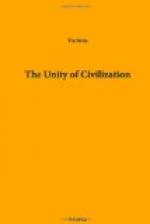CHAPTER VI. THE COMMON ELEMENTS IN EUROPEAN LITERATURE AND ART
The question of the place of nationality in art and literature. It has little or no place in the Middle Ages. The mediaeval epic; its character. The mediaeval romance. Modern European art and literature transcends national conditions. The characteristics of the new European literature of the fourteenth century: Dante, Boccaccio, Chaucer. The drama of England and Spain in the sixteenth and seventeenth centuries. Painting and sculpture from the fourteenth to the seventeenth century. The classical mind, and the principle of good taste and common sense. The realism of Defoe and Hogarth, and the Spanish Picaresque novel. Sentimentalism in the eighteenth century. The poetry and painting of nature. The great revolution and the romantic movement. Great literature and art are not national but human.
CHAPTER VII. SCIENCE AND PHILOSOPHY
Western civilization possesses a certain unity (1) in the sense of unity of character, (2) in the fact that it has a common origin, ultimately in the Greco-Roman civilization but more immediately in mediaeval Christendom, and (3) in the sense that its parts have maintained a constant intercommunication of ideas. (4) The different qualities of German, French, and English thinkers have in large measure complemented one another, (5) and the history of science and of speculative philosophy is largely a history of the interaction of distinct national schools. (6) The same thing is true of political thought. (7) Thus the world of thought forms a commonwealth which is superior to all national differences and, in spite of the war, remains a foundation of a very genuine unity.
CHAPTER VIII. UNITY IN EDUCATION
Distinction between Unity and Uniformity. Historical Unity; the origin of the School and the University. Both instruments of the mediaeval Church for maintaining a common system throughout Western Christendom. Importance of Latin as the universal language of education. Suppression of the vernacular and of national movements. The Reformation; a common European movement. Erasmus. The new teaching based on classical literature. Tendency to disunion; the influence of the Reformation and the national Churches. Growth of national literature. Political influences, the French Revolution, and the National State. The essential Unity still preserved, not merely in the study of the natural sciences, but in the historical unity given by Christianity and the spirit of Greece.




